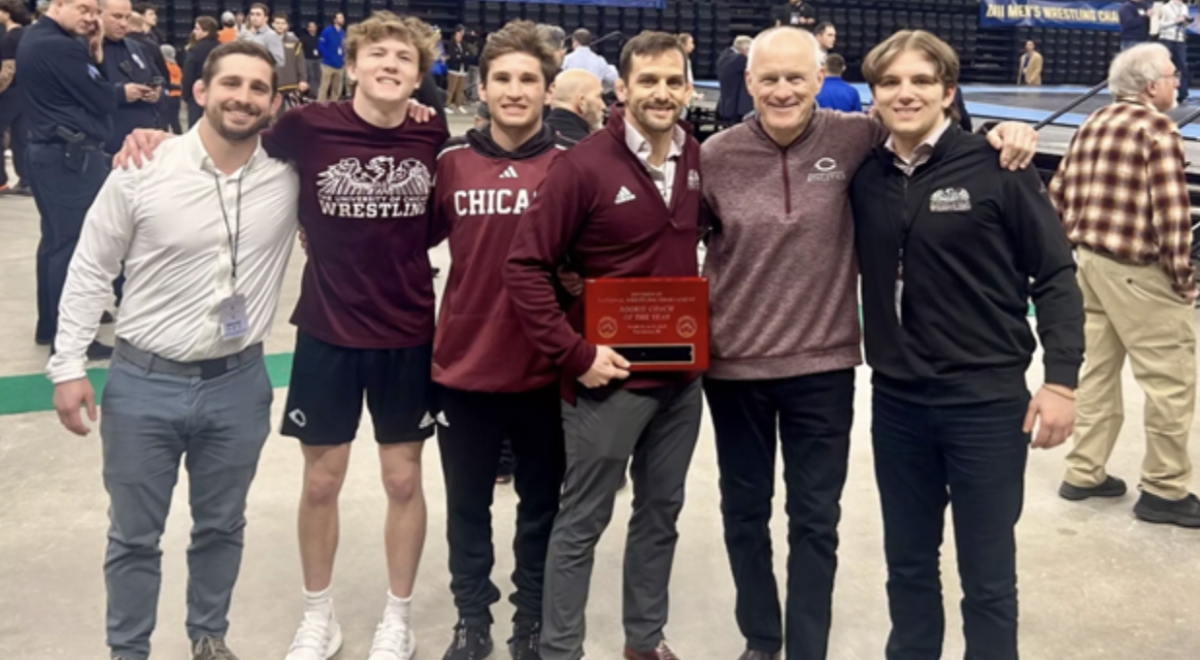When their boat finished in the middle of the pack at the Head of the Charles Regatta in 2012, Ariel Stevenson and Sara Mohr promised their graduating coxswain that they would win a medal for her.
Now fourth-years and the crew club’s captain and president, respectively, Stevenson and Mohr came through with a second-place finish in the Women’s Collegiate Fours division at last weekend’s Head of the Charles race. Fourth-year Emily Anagnostos, second-year Suzanne Lechner, and fourth-year coxswain Marc Kealhofer rounded out their boat.
The Head of the Charles is the world’s largest regatta, attracting some 11,000 athletes and 400,000 spectators to Cambridge, MA, for 60 races over two days. The Charles is a chance for participants to mingle with Olympic rowers—Stevenson said she made sure to get a picture two years ago—and with alumni. The Maroons were staying with Broadview’s original Resident Heads, and they received their medals from their former coxswain, who was volunteering at the medal stand.
Competing against schools like Trinity, Penn State, and UC Santa Barbara, the Maroons finished in 18:54, about half a minute behind first-place Barry University. Their previous best had been fifth place, in 2011. The team also sent a men’s boat, which finished last out of 44 boats after incurring a penalty for hitting another boat’s oars.
Coach Trish Brubaker said that before the race, she thought the women’s four “had a shot at winning a medal.”
“I’ve worked with all of them for a while, so their potential has always been very apparent to me,” she said.
Before embarking on the Charles’s famously serpentine three-mile course (there is a full 180-degree turn at the two-mile mark, which is rare), boats line up single-file in the order they finished last year. This meant that the Maroons started 12th, behind Lafayette and in front of Illinois. The women’s four has a tendency to “try to crush it,” said Brubaker, so she had them start off slow to keep them relaxed.
But about a mile into the race, the Maroons upped their tempo from 32 to 34 strokes per minute, according to Stevenson. “We passed Lafayette in five strokes, which is impressive.”
The Maroons had a scare under the second bridge, where they got too close to Wheaton’s boat and clashed oars. They found out later, though, that the judges decided to give the minute penalty to Wheaton instead of Chicago. From there, the race was smooth rowing.
“They looked relaxed but powerful and committed,” Brubaker said, who followed the team along on her bike. “A lot of times in head races you can’t really tell how fast your crew is going. In this case, their speed was very visible. With every stroke, you could see the crew gaining on the boats that started ahead of them.”
Mohr deferred credit to the boat’s coxswain, Kealhofer.
“Sitting at the start line, not knowing how well we were going to do, it was very reassuring to know we had someone like Marc, who was in control,” Mohr said. “He steered a perfect course, so we didn’t have to worry about anything, we just had to pull, and we knew Marc was going to get us there.”
The Maroons have two races left in their fall season: a scrimmage against Illinois and the Head of the Hooch at Chattanooga.
The crew team has grown rapidly in the last few years, and Mohr credited some success to that depth.
“To have a fast four, you need more than four women willing to put the work in,” she said. “Our whole women’s team is very strong. We’re committed to that, and we push each other to be better.”
Between that and the club’s improved financial situation—the club is in the black for the first time since a former president put them into debt to buy two boats six years ago—Chicago crew’s outlook for the spring season is quite rosy.








